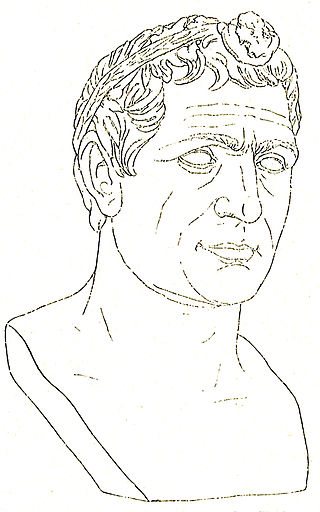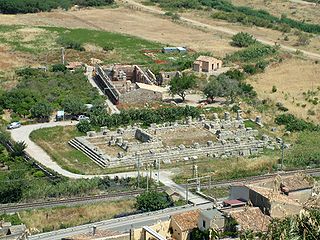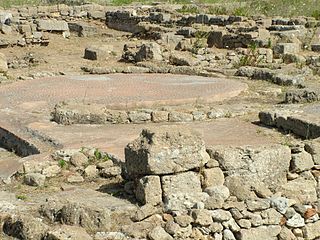Phintias was an ancient Greek tyrant of the Sicilian town of Acragas (c. 288 - 279 BC) in Magna Graecia. He appears to have established his power over that city during the period of confusion which followed the death of Agathocles (289 BC), about the same time that Hicetas obtained the chief command at Syracuse. War soon broke out between the two despots, in which Phintias was defeated near Hybla. [1]
But this success having induced Hicetas to engage with a more formidable enemy, the Carthaginians, he was defeated in his turn, and Phintias, who was probably in alliance with that power, was now able to extend his authority over a considerable part of Sicily. Among the cities subject to his rule we find mention of Agyrium, which is a sufficient proof of the extent of his dominions.
He at the same time made a display of his wealth and power by founding a new city, to which he gave his own name Phintias, and whither he removed all the inhabitants from Gela, which he razed to the ground. His oppressive and tyrannical government subsequently alienated the minds of his subjects, and caused the revolt of many of the dependent cities. But he had the wisdom to change his line of policy, and, by adopting a milder rule, retained possession of the sovereignty until his death. The period of this is not mentioned, but it may probably be inferred from the fragments of Diodorus, that it preceded the expulsion of Hicetas from Syracuse, and may therefore be referred to 279 BC. [2]
There are extant coins of Phintias which indicate that he assumed the title of king, in imitation of Agathocles. They all have the figure of a boar running on the reverse, and a head of Apollo or Diana on the obverse. Those which show the head of Phintias himself are probably spurious.

Agathocles was a Greek tyrant of Syracuse (317–289 BC) and self-styled king of Sicily (304–289 BC).

Syracuse is a historic city on the Italian island of Sicily, the capital of the Italian province of Syracuse. The city is notable for its rich Greek and Roman history, culture, amphitheatres, architecture, and as the birthplace and home of the pre-eminent mathematician and engineer Archimedes. This 2,700-year-old city played a key role in ancient times, when it was one of the major powers of the Mediterranean world. Syracuse is located in the southeast corner of the island of Sicily, next to the Gulf of Syracuse beside the Ionian Sea. It is situated in a drastic rise of land with 2,000 metres (6,600 ft) depths being close to the city offshore although the city itself is generally not so hilly in comparison.

This article concerns the period 309 BC – 300 BC.
Abacaenum was an ancient city of Sicily, situated about 6.5 km from the north coast, between Tyndaris and Mylae, and 13 km from the former city.

Himera, was a large and important ancient Greek city in Magna Graecia, situated on the north coast of Sicily at the mouth of the river of the same name, between Panormus and Cephaloedium in the comune of Termini Imerese.

Megara Hyblaea – perhaps identical with Hybla Major – is an ancient Greek colony of Magna Graecia in Sicily, situated near Augusta on the east coast, 20 kilometres (12 mi) north-northwest of Syracuse, Italy, on the deep bay formed by the Xiphonian promontory. There were at least three cities named "Hybla" in ancient accounts of Sicily which are often confounded with each other, and among which it is sometimes very difficult to distinguish.

The Battle of the Crimissus was fought in 339 BC between a large Carthaginian army commanded by Asdrubal and Hamilcar and an army from Syracuse led by Timoleon. Timoleon attacked the Carthaginian army by surprise near the Crimissus river in western Sicily and won a great victory. When he defeated another much smaller force of Carthaginians shortly afterwards, Carthage sued for peace. The peace allowed the Greek cities on Sicily to recover and began a period of stability. However, another war between Syracuse and Carthage erupted after Timoleon's death, not long after Agathocles seized power in 317 BC.

The Sicilian Wars, or Greco-Punic Wars, were a series of conflicts fought between ancient Carthage and the Greek city-states led by Syracuse, Sicily over control of Sicily and the western Mediterranean between 580 and 265 BC.

Heraclea Minoa was an ancient Greek city of Magna Graecia situated on the southern coast of Sicily near the mouth of the river Halycus, 25 km west of Agrigentum. It is located near the modern town of the same name in the comune Cattolica Eraclea in Italy.
Hicetas was tyrant of Syracuse, Magna Graecia, during the interval between the reign of Agathocles and that of Pyrrhus. After the death of Agathocles his supposed assassin, Maenon, put to death Archagathus, the grandson of Agathocles; and assuming the command of the army with which the latter was besieging Aetna, directed his arms against Syracuse. Hereupon Hicetas was sent against him by the Syracusans, with a considerable army: but after the war had continued for some time, without any decisive result, Maenon, by calling in the aid of the Carthaginians, obtained the superiority, and the Syracusans were compelled to conclude an ignominious peace. Soon after ensued the revolution which led to the expulsion of the Campanian mercenaries, afterwards known as the Mamertines: and it must have been shortly after this that Hicetas established himself in the supreme power, as we are told by Diodorus that he ruled nine years. The only events of his government that are recorded are a war with Phintias, tyrant of Agrigentum, in which he obtained a considerable victory, and one with the Carthaginians, by whom he was defeated at the river Terias. He was at length expelled from Syracuse by Thynion, an event which took place not long before the arrival of Pyrrhus in Sicily, and must therefore be referred either to 279 BC or 278 BC,either of which dates is consistent enough with the period of nine years allotted to his reign by Diodorus.

Bibliotheca historica is a work of universal history by Diodorus Siculus. It consisted of forty books, which were divided into three sections. The first six books are geographical in theme, and describe the history and culture of Egypt, of Mesopotamia, India, Scythia, and Arabia (II), of North Africa (III), and of Greece and Europe (IV–VI). In the next section, he recounts human history starting with the Trojan War, down to the death of Alexander the Great. The last section concern the historical events from the successors of Alexander down to either 60 BC or the beginning of Caesar's Gallic War in 59 BC. He selected the name "Bibliotheca" in acknowledgement that he was assembling a composite work from many sources. Of the authors he drew from, some who have been identified include: Hecataeus of Abdera, Ctesias of Cnidus, Ephorus, Theopompus, Hieronymus of Cardia, Duris of Samos, Diyllus, Philistus, Timaeus, Polybius and Posidonius.
The siege of Segesta took place either in the summer of 398 BC or the spring of 397 BC. Dionysius the Elder, tyrant of Syracuse, after securing peace with Carthage in 405 BC, had steadily increased his military power and tightened his grip on Syracuse. He had fortified Syracuse against sieges and had created a large army of mercenaries and a large fleet, in addition to employing catapults and quinqueremes for the first time in history. In 398 BC he attacked and sacked the Phoenician city of Motya despite a Carthaginian relief effort led by Himilco II of Carthage. While Motya was under siege, Dionysius besieged and assaulted Segesta unsuccessfully. Following the sack of Motya, Segesta again came under siege by Greek forces, but the Elymian forces based in Segesta managed to inflict damage on the Greek camp in a daring night assault. When Himilco of Carthage arrived in Sicily with the Carthaginian army in the spring of 397 BC, Dionysius withdrew to Syracuse. The failure of Dionysius to secure a base in western Sicily meant the main events of the Second Sicilian war would be acted out mostly in eastern Sicily, sparing the Elymian and Phoenician cities the ravages of war until 368 BC.
The sack of Camarina in Sicily was an act of war that took place during the Sicilian Wars in 405 BC.
The siege of Syracuse by the Carthaginians from 311 to 309 BC followed shortly after the Battle of the Himera River in the same year. In that battle the Carthaginians, under the leadership of Hamilcar the son of Gisco, had defeated the tyrant of Syracuse, Agathocles. Agathocles had to retreat to Syracuse and lost control over the other Greek cities on Sicily, who went over to the Carthaginian side.

The Battle of White Tunis was fought between Carthage and the tyrant Agathocles of Syracuse in 310 BC. It was the first large battle of the Agathocles' military expedition to Libya. Even though heavily outnumbered by the Carthaginian army, the soldiers of Agathocles were far more experienced in warfare than the Carthaginian citizen soldiers. Another important factor was the terrain, which prevented the Carthaginians from using their numbers to outflank Agathocles. The Carthaginian suffered a serious defeat, which caused some of the Carthaginian allies to change their allegiance to Agathocles.

The siege of Syracuse from 344 to 343/342 BC was part of a war between the Syracusan general Hicetas and the tyrant of Syracuse, Dionysius II. The conflict became more complex when Carthage and Corinth became involved. The Carthaginians had made an alliance with Hicetas to expand their power in Sicily. Somewhat later, the Corinthian general Timoleon arrived in Sicily to restore democracy to Syracuse. With the assistance of several other Sicilian Greek cities, Timoleon emerged victorious and reinstated a democratic regime in Syracuse. The siege is described by the ancient historians Diodorus Siculus and Plutarch, but there are important differences in their accounts.
The siege of Syracuse in 278 BC was the last attempt of Carthage to conquer the city of Syracuse. Syracuse was weakened by a civil war between Thoenon and Sostratus. The Carthaginians used this opportunity to attack and besiege Syracuse both by land and sea. Thoenon and Sostratus then appealed to king Pyrrhus of Epirus to come to the aid of Syracuse. When Pyrrhus arrived, the Carthaginian army and navy retreated without a fight.
The history of Greek and Hellenistic Sicily began with the foundation of the first colonies around the mid 8th century BC. The Greeks of Sicily were known as Siceliotes.
![]() This article incorporates text from a publication now in the public domain : Smith, William, ed. (1870). "Phintias (2)". Dictionary of Greek and Roman Biography and Mythology .
This article incorporates text from a publication now in the public domain : Smith, William, ed. (1870). "Phintias (2)". Dictionary of Greek and Roman Biography and Mythology .









